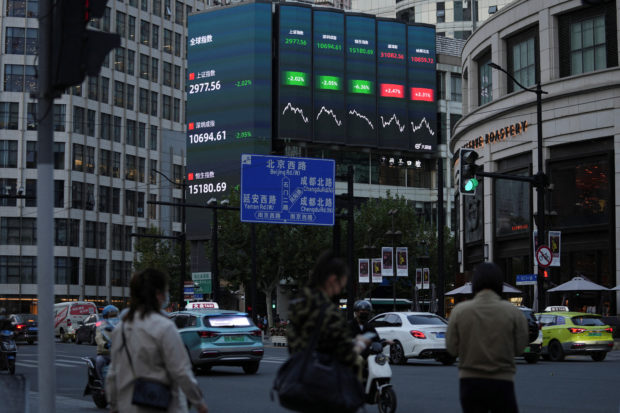
A view of a giant display of stock indexes, following the coronavirus disease (COVID-19) outbreak, in Shanghai, China Oct 24, 2022. REUTERS/Aly Song/File photo
SINGAPORE – Asia’s stock markets slipped on Wednesday as reality bit on hopes for a soft economic landing in the United States, curbing investors’ enthusiasm about China’s major shift in its tough zero-COVID policy.
Warnings from big U.S. banks about a likely recession next year pushed the S&P 500 lower for a fourth straight session on Tuesday and the brakes have come on a rally that has lasted almost two months.
Oil also fell sharply and, with Brent futures at $79.50 a barrel, is back where it began the year.
MSCI’s broadest index of Asia-Pacific shares outside Japan fell 0.2 percent and Japan’s Nikkei fell 0.7 percent.
“Some of the optimism that had driven the rally is being put to the test,” said Shane Oliver, head of investment strategy at Australia’s AMP.
“We might be transitioning from a situation of worrying about inflation and interest rates, to one where the negatives become weakening growth and falling profits.”
S&P 500 futures were flat by mid-afternoon in Asia, while European futures rose 0.1 percent.
China’s national health authority said on Wednesday that asymptomatic COVID-19 cases and those with mild symptoms can self-treat while in quarantine at home.
While some of the changes announced echoed similar easing moves made by other countries many months ago, the announcement was the strongest sign so far that China is preparing its people to live with the disease after nearly three years of crippling restrictions that have battered the economy.
Market reaction, however, was muted as the focus shifts to how well China can execute its policy shift, especially if new COVID cases surge over winter. Analysts say the path to fully reopening the economy will be long and bumpy, and not without risk.
The Shanghai Composite Index fell 0.6 percent, Hong Kong’s Hang Seng fell 1 percent and the yuan was broadly steady, giving up early gains.
“The reality on the ground is still one of continued pressure, even as the outlook is improving somewhat,” said Mitul Kotecha, head of emerging markets’ strategy at TD Securities in Singapore.
Adding to the darkening demand outlook globally, China earlier in the day reported grim trade data for November, with both imports and exports suffering their biggest monthly falls since 2020 – auguring badly for recovery prospects.
India on Wednesday was the latest central bank to start slowing the pace of rate increases, with a hike of its key lending rate by 35 basis points to 6.25 percent, smaller than the three 50 bp hikes it delivered previously. Canada is the next cab off the rank with a rates decision expected at 1500 GMT.
Slowdown
In the United States, big banks are bracing for a worsening economy next year as inflation and rate rises threaten consumer demand, with top executives at Goldman Sachs, J.P. Morgan and Bank of America all sounding downbeat in remarks on Tuesday.
“Economic growth is slowing,” said Goldman Sachs CEO David Solomon. “When I talk to our clients, they sound extremely cautious.”
The growth fears rallied longer-dated bonds and helped the safe-haven U.S. dollar to pause its recent retreat.
The yield on benchmark 10-year U.S. Treasuries fell 8.6 basis points to 3.513 percent overnight and was last at 3.546 percent. That is more than 80 bps below the two-year yield as investors reckon on high rates hurting growth.
Oil prices have also been sliding with declining demand expectations and now sit more than 40 percent below a high of nearly $140 a barrel made shortly after Russia’s invasion of Ukraine on Feb. 24.
In foreign exchange markets, the dollar was seeking to steady after excitement about a slowdown in U.S. rate hikes recently knocked it from the year’s highs.
It was firm at 137.28 yen in Asia on Wednesday and traded at $1.0467 per euro. The Australian dollar was broadly steady at $0.6680 despite Australian third-quarter growth coming in a bit below forecasts.
The Canadian dollar hovered at 1.3644 per dollar ahead of an expected rate hike from the Bank of Canada later on Wednesday. The U.S. dollar index sat at 105.5.
Spot gold was steady at $1,773 an ounce and bitcoin, at $17,000, was going nowhere with cryptocurrency sentiment fragile as the fallout from the collapse of FTX ripples through the sector.